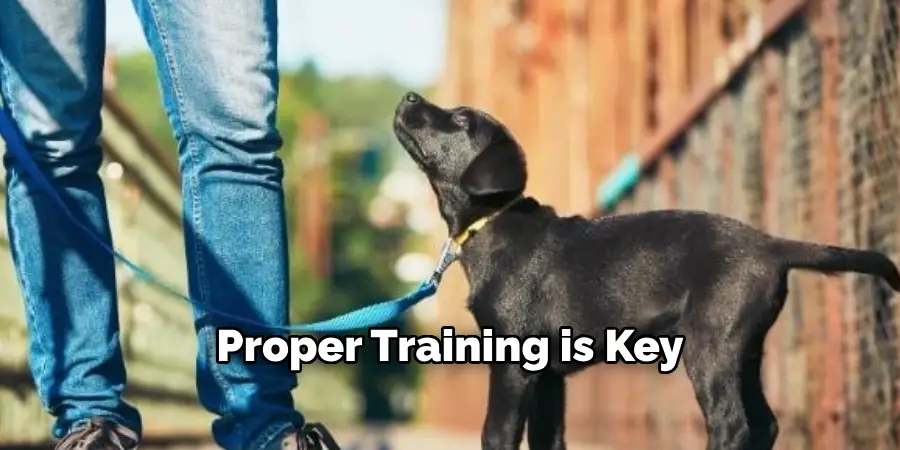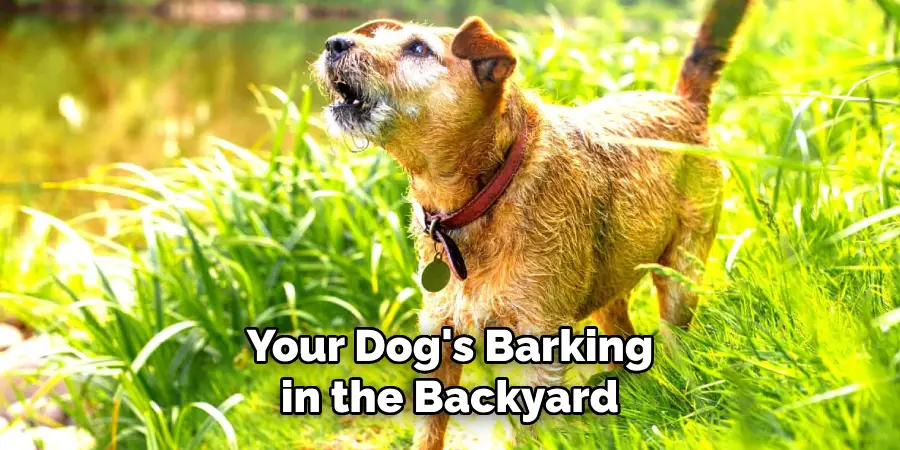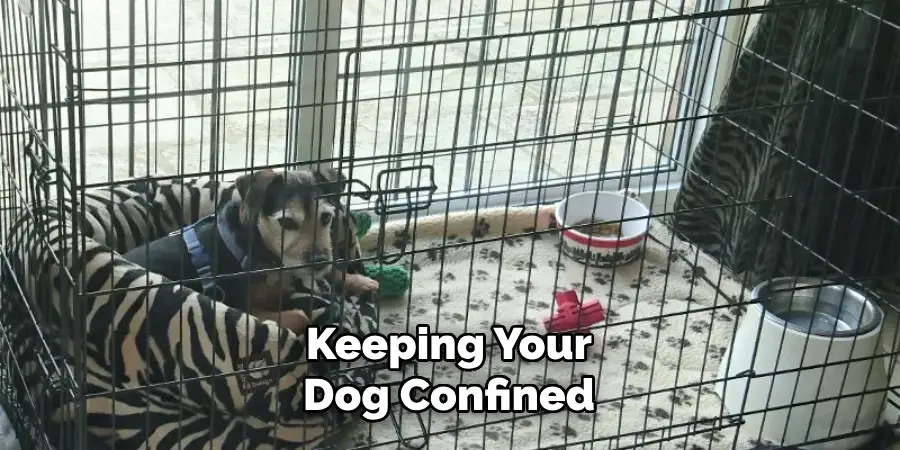Dogs barking in the backyard can be a nuisance not only to you but also to your neighbors. It can disrupt peace and cause tension between you and those living around you. As a dog owner, it is your responsibility to ensure that your canine companion does not excessively bark in the backyard.

There can be various reasons why dogs bark in the backyard, such as
boredom, territorial behavior, fear, or seeking attention. It is important to understand the root cause of your dog’s barking in order to effectively stop it. In this guide, we will discuss some tips and strategies on how to stop dog barking in backyard.
Necessary Items
Before we dive into the tips and strategies, it is important to have these necessary items on hand to effectively address your dog’s barking:
- Treats: Having some tasty treats handy can help distract your dog from barking and reinforce positive behavior.
- Leash and Collar: These tools can be helpful in redirecting your dog’s attention and guiding them toward the desired behavior.
- Toys: Dogs are social animals and need mental and physical stimulation. Having appropriate toys can keep your dog entertained and reduce boredom barking.
- Bark Control Devices: These are helpful tools that emit sound or vibration when a dog barks, which can help deter them from excessive barking.
12 Steps on How to Stop Dog Barking in Backyard
Step 1: Train Your Dog

Proper training is key when it comes to stopping your dog from barking excessively. Enroll your dog in obedience training classes or seek the help of a professional dog trainer to teach them basic commands such as “sit,” “stay,” and “quiet.” This will give you better control over your dog’s behavior.
Step 2: Identify the Cause of Barking
As mentioned earlier, there can be various reasons why dogs bark in the backyard. Spend some time observing your dog’s behavior and try to identify the trigger for their barking. This will help you address the root cause.
Step 3: Reward Quiet Behavior
When your dog is not barking in the backyard, make sure to reward them with treats and positive reinforcement. This will teach them that being quiet is a desirable behavior. And when they do bark, use a firm and calm voice to say “quiet” and reward them when they stop barking.
Step 4: Exercise Your Dog
Dogs need daily exercise to release their energy and prevent boredom. A tired dog is less likely to bark excessively in the backyard. Take your dog for walks or play interactive games with them to ensure they are getting enough physical activity.
Step 5: Create a Designated Barking Area
If your dog tends to bark in a specific area of the backyard, consider creating a designated barking area for them. This can be a corner of the yard with fewer distractions where they can bark freely without disturbing others.
Step 6: Provide Mental Stimulation

In addition to physical exercise, dogs also need mental stimulation. This can include puzzle toys, interactive games, or training sessions. Keeping your dog mentally engaged can reduce their need to bark out of boredom.
Step 7: Block the View
If your dog is barking at something they see outside the backyard, try blocking their view with a fence or plants. This can help reduce their visual stimulation and decrease their barking.
Step 8: Desensitize Your Dog
If your dog tends to bark at certain triggers, such as the doorbell or other dogs, try desensitizing them through gradual exposure. For example, if your dog barks at the doorbell, have a friend ring it multiple times while giving your dog treats until they no longer react to the sound.
Step 9: Use a Bark Control Device
As mentioned earlier, bark control devices can be helpful in deterring excessive barking. Consider using one if your dog’s barking is becoming a major issue. Also, make sure to consult with a professional before using any aversive training tools.
Step 10: Address Separation Anxiety
Some dogs may bark excessively when they are left alone in the backyard due to separation anxiety. If this is the case for your dog, seek help from a professional behaviorist to address their anxiety and develop coping mechanisms.
Step 11: Be Consistent
Consistency is key when it comes to training your dog. Make sure all family members are on the same page and use the same methods to address barking in the backyard. This will prevent confusion for your dog and help reinforce desired behavior.
Step 12: Seek Professional Help if Needed
If you have tried various methods and your dog’s barking in the backyard continues to be a problem, seek help from a professional dog trainer or behaviorist. They can assess the situation and provide personalized solutions for your specific dog.

Barking is a natural behavior for dogs, but excessive barking in the backyard can cause issues for you and those around you. With proper training, exercise, and addressing any underlying causes, you can effectively stop your dog from barking in the backyard.
Remember to be patient and consistent with your training, and seek help if needed. With these tips, you and your neighbors can enjoy a peaceful backyard without constant barking. Overall, being a responsible dog owner means understanding your dog’s needs and addressing any behavior issues in a positive and effective manner.
9 Safety Measures
1) Secure the perimeter
First and foremost, ensure that all fences and gates are secure and tall enough to prevent your dog from jumping over them. This not only keeps your dog safe within your property but also reduces barking at pedestrians or animals passing by.
2) Visibility blockers
Consider installing privacy screens or planting dense shrubbery along the fence line to block your dog’s view of the street or neighboring yards, which can decrease stimuli that cause barking.

3) Regular vet check-ups
Sometimes, excessive barking can be a sign of underlying health issues. Regular vet check-ups ensure your dog is healthy and not barking due to discomfort or pain.
4) Identification
Ensure your dog wears a collar with ID tags at all times, and consider microchipping as a more permanent form of identification. This is crucial if they manage to escape the yard despite your best efforts.
5) Behavioral training
Invest in professional training if the barking is due to behavioral issues. A trained dog is not only safer but also happier. Plus, a well-behaved dog means less barking in the backyard.
6) Socialization
Proper socialization is essential for dogs to learn appropriate behavior around people and other animals. This can reduce territorial barking in the backyard. Also, consider enrolling your dog in doggie daycare or taking them to the dog park regularly for socialization opportunities.
7) Supervision
Never leave your dog unattended in the backyard for long periods. This not only increases the risk of escape but also leaves them vulnerable to potential dangers such as predators or weather hazards. Then, their barking may be a cry for help.

8) Weather precautions
In extreme weather conditions, ensure your dog has shelter and access to water in the backyard. Also, never leave them out during thunderstorms or other severe weather events that can trigger fear-based barking.
9) Neuter/spay
If you have not already done so, consider spaying or neutering your dog. This can decrease hormone-driven behaviors such as excessive territorial barking and aggression towards other animals. Also, it is a responsible choice for pet ownership to prevent unwanted litter and reduce the number of stray dogs in communities.
Barking is a natural form of communication for dogs, but excessive barking in the backyard can be a nuisance and even a safety concern. By following these tips on how to stop dog barking in backyard, you can effectively manage your dog’s barking behavior while keeping them safe in the backyard.
Remember to always prioritize your dog’s physical and mental well-being while addressing any behavior issues. Ultimately, with proper training and precautions, you can enjoy a peaceful backyard with your furry friend by your side.
8 Things to Avoid
1) Punishment
Punishing your dog for barking can have negative effects and may even worsen their behavior. Avoid yelling, physical correction, or any aversive training methods. As a responsible pet owner, it is your job to train and guide your dog in a positive and safe manner.
2) Excessive Confinement

Keeping your dog confined for long periods without exercise or mental stimulation can lead to boredom, frustration, and excessive barking. Make sure to provide regular opportunities for playtime and walks.
3) Rewarding
Do not inadvertently reinforce barking behavior by giving your dog attention, treats, or other rewards when they bark. This can teach them that barking leads to positive outcomes and encourage more barking in the future.
4) Ignoring underlying issues
If your dog’s excessive barking is due to underlying causes such as separation anxiety or fear, ignoring these issues will not solve the problem. Address these issues and provide your dog with proper support and training.
5) Inconsistency
Consistency is crucial when it comes to training your dog. Inconsistent methods or rules can confuse your dog, leading to more barking behavior. Make sure all family members are on the same page and follow a consistent approach.
6) Encouraging territorial behavior
Avoid encouraging your dog’s territorial behavior, such as barking at anyone who passes by or enters your property. This can escalate to aggression and cause safety concerns for both you and your dog.
7) Lack of exercise
A tired dog is a happy dog. Make sure your furry friend gets enough physical activity to release excess energy and reduce boredom, which can lead to barking. This is especially crucial for high-energy breeds.
8) Not seeking help
If your dog’s excessive barking persists despite your best efforts, do not hesitate to seek professional help. A certified dog trainer or behaviorist can provide personalized guidance and support in addressing the issue effectively. Remember that it is never too late to seek help and improve your dog’s behavior.
With patience, consistency, and proper training, you can successfully manage your dog’s barking in the backyard. Don’t give up on your furry friend – they rely on you to be their responsible and loving owner. So take care of them, train them well, and enjoy a peaceful backyard experience with your loyal companion by your side.
8 Additional Tips
1) White Noise or Calming Music
Play white noise or calming music in the backyard to help drown out external noises that may trigger barking. This can also create a soothing atmosphere for your dog. Soothing scents like lavender or chamomile can also have a calming effect on dogs.

2) Use Positive Reinforcement
Instead of punishing your dog for barking, use positive reinforcement techniques to reward them for not barking. This can include treats, praise, and playtime when they remain calm in the backyard. Some dogs may respond well to clicker training for barking behavior.
3) Consider a Bark Collar
If all other methods fail and your dog’s excessive barking becomes a serious issue, you may consider using a bark collar. These collars emit a sound or mild vibration when the dog barks, discouraging them from continuing the behavior. However, this should only be used as a last resort and with the guidance of a professional trainer.
4) Involve Your Neighbors
If your dog’s barking is causing disturbance for your neighbors, it may be helpful to involve them in finding a solution. They can provide feedback on when and why your dog is barking, which can help you address the root cause. Keeping open communication with your neighbors can also help prevent any conflicts.
5) Socialization
Proper socialization from a young age can help prevent fear-based barking and aggression towards other animals. Expose your dog to different people, animals, and environments in a controlled and positive setting.
6) Desensitization Training
For dogs who bark at specific triggers, such as cars or mail carriers, desensitization training can be effective. This involves gradually exposing your dog to the trigger while rewarding them for remaining calm.
7) Check for Health Issues
Excessive barking can also be a sign of underlying health issues. If your dog’s barking behavior suddenly changes, it is essential to consult with a veterinarian to rule out any medical conditions.
8) Be Patient
Remember that changing behavior takes time, patience, and consistency. Do not get discouraged if your dog’s barking does not improve overnight. Keep practicing positive reinforcement techniques and seek professional help if needed. Your furry friend will thank you for it! With these tips in mind, you can create a peaceful and enjoyable backyard experience for both you and your four-legged companion.
Remember to prioritize your dog’s mental and physical well-being while addressing any behavior issues. With the right approach on how to stop dog barking in backyard and patience, you can create a happy and peaceful environment for both you and your furry friend in the backyard. So be patient, be consistent, and most importantly, show your dog love and understanding throughout the training process.
Frequently Asked Questions
My Dog Barks at Everything in the Backyard. How Can I Make Them Stop?
It is essential to identify the root cause of your dog’s excessive barking. Is it out of boredom or frustration? Are they territorial or fearful? Once you determine the cause, you can address it with training and behavior modification techniques. It may also be helpful to provide your dog with more mental and physical stimulation through toys, games, and exercise.
What is the Best Way to Train My Dog Not to Bark?
The best way to train your dog not to bark is through positive reinforcement techniques. Reward them for remaining calm and quiet, and discourage barking by withholding attention or treats when they do bark. Consistency and patience are key in training and behavior.
Is it Okay to Use a Bark Collar on My Dog?
Bark collars should only be used as a last resort and with the guidance of a professional trainer. They can have adverse effects on some dogs, causing fear or aggression. It is essential to explore other methods first before considering a bark collar.
My Dog Only Barks When I Leave Them Alone in the Backyard, What Can I Do?
Your dog may be experiencing separation anxiety, which can manifest in excessive barking. Gradually increasing the time spent alone in the backyard and providing them with engaging activities, such as puzzle toys or a comfortable spot to relax, can help alleviate their anxiety. Consulting with a professional trainer or behaviorist may also be beneficial in addressing separation anxiety.
By understanding the underlying cause of your dog’s barking and using proper training techniques, you can address this behavior and create a more peaceful backyard experience for both you and your furry friend. Remember to be patient and consistent, and always prioritize your dog’s well-being above all else.
Conclusion
Excessive barking can be a frustrating issue for dog owners, but with proper understanding of how to stop dog barking in backyard, patience, and training, it can be managed effectively. Remember to avoid punishment, seek professional help if needed, and involve your neighbors in finding a solution.
With consistency and positive reinforcement techniques, you can have a quiet and happy backyard with your beloved dog. So start implementing these tips today, and create a peaceful outdoor space for you and your furry friend to enjoy together! So go ahead, take on the challenge of managing your dog’s barking behavior, and reap the rewards of a well-behaved and contented canine companion.

